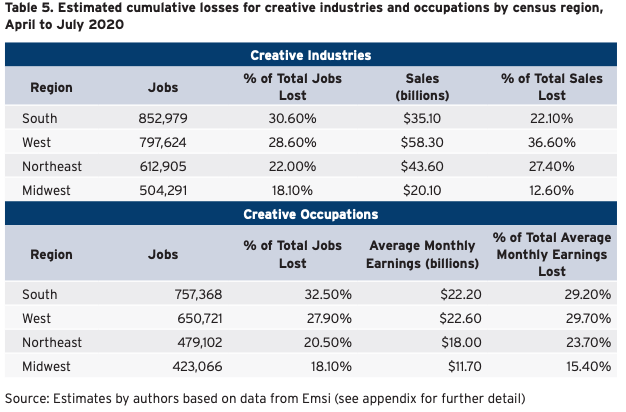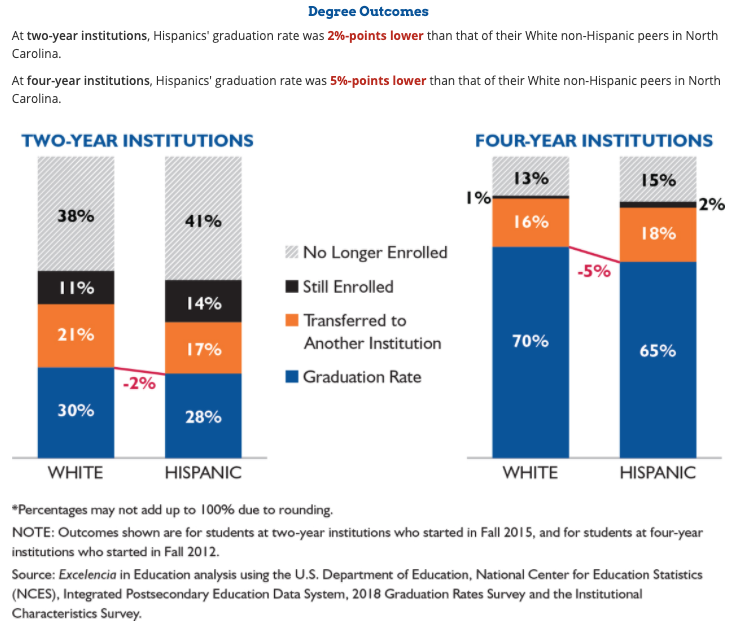Need to know: COVID-19
- As of noon on Friday, August 21, there were 151,912 confirmed cases. See cases by county here.
- The share of positive tests as a percentage of total tests is back up at 8% after an increase in positive cases this week.
- As of August 21, 1,015 people were hospitalized with ~24% of ICU beds available.
- From March 15 to August 19, 1,242,534 North Carolinians have filed unemployment insurance claims. The state has paid 862,221 claimants.
Dropping knowledge
Brookings Institute published a new report estimating the losses to the country’s creative sector due to COVID-19, and the results are sobering. From April 1 to July 31, 2020, they estimate:
- 2.7 million jobs lost (33% of all jobs) and more than $150 billion lost in sales of goods and services for creative industries (film, advertising, fashion, etc.).
- 2.3 million jobs lost (30% of all jobs) and $74 billion lost in average monthly earnings for the creative occupations (musicians, artists, performers, etc.).
The report estimates the top creative jobs lost will be photographers, musicians and singers, writers and authors, and actors. They also break it down by region and estimate that job losses in creative industries and occupations will be largest in the South while sales losses in creative industries will be largest in the West (largely due to California’s film, radio, and television industries).
 Two southern cities known for their creative sectors, New Orleans and Nashville, are estimated to have the highest share of job losses in creative occupations. The authors provide some recommendations to help the creative economy, including additional federal relief, direct stipends to artists, and technical support to help smaller organizations conform with health and safety requirements. They close by stating:
Two southern cities known for their creative sectors, New Orleans and Nashville, are estimated to have the highest share of job losses in creative occupations. The authors provide some recommendations to help the creative economy, including additional federal relief, direct stipends to artists, and technical support to help smaller organizations conform with health and safety requirements. They close by stating:
“Imagine our cities and communities devoid of arts and culture, with no concerts, no theaters, and no art galleries. For the creative economy to survive and thrive again, a broad-based recovery strategy is needed.”
For your consideration
Excelencia in Education released a report looking at Latinx student degree attainment. For 2017-18, 24% of Latino adults ages 25 or older had attained an associate degree or higher compared to 46% of white non-Hispanic adults. In North Carolina, those numbers are 22% and 46%, respectively. Hispanic students enrolled at two- and four-year colleges in North Carolina were also less likely to graduate than their white counterparts.

In July, EdNC published a series looking at Latinx student experiences in K-12 and community colleges. You can find those stories here.
Need to know: COVID-19 rates by district
The Hunt Institute has created an interactive map showing COVID-19 cases and death rates by school district across the country and in North Carolina. They will be updating this map regularly and hope educators, policymakers, community organizers, and others use it to make decisions around learning this fall. Find your district here.
What we're reading
North Carolina’s teacher and student demographics | Recruiting and retaining teachers of color
Explore teacher and student demographics by district, and learn what North Carolina can do to promote and retain Black educators.... Read the rest
-
Ed Dept pitches new grants to help colleges rebound from the pandemic
-
Long-Haulers Are Redefining COVID-19
-
Contact Tracers in Massachusetts Might Order Milk or Help With Rent. Here’s Why.
-
A secret hidden in centuries-old mud reveals a new way to save polluted rivers
-
Individual Circadian Clocks Might Be the Next Frontier of Personalized Medicine
-
Millennial moms nearly three times more likely than dads to forgo work because lack of child care or school


